Important Point
What Is Taper Turning?
In simple linear turns, the cutting tool moves along a line parallel to the axis of the workpiece so that the finished workpieces always have the same diameter. However, when cuttings the taper, the tool will move at an angle relative to the workpiece’s axis, resulting in the taper.
Therefore, to rotate the taper, the workpieces must be installed on the lathe, so that axis of rotations is at an angle to the axis of the lathe, or the cuttings tool moves a lathe at an angle relative to the axis of the bend. When the diameters of a piece change uniformly from one end to the other, the pieces are called taper.
Taper turning is a machining operation, which means that the diameter of cylindrical workpieces gradually decreases from one part to another. The taper can be external or internal. If the workpiece is taped outward, it has an outer taper. If it is taped inward, it has an internal taper.
Also, Read: Parts of Turret Lathe | Working of Turret Lathe | Types of Turret Lathe | Advantages of Turret Lathe
Taper Turning and Its Types:
Taper turning is a turning process in which the cutting tool moves at an angle to the axis of the workpieces so that the workpiece receives a tapered shape. In a tapered piece, the diameter of the workpiece varies uniformly from one end to the other. The workpiece can be taped from inside or outside.
The workpiece must be positioned in such a way as to make the taper such that the axis of rotation is at the angle to an axis of the bend.
When using any method to make the taper, the cutting edge of the tool must be placed on the center of the axis of the workpiece. If the cutting edge is not properly positioned at the center of the axis of the workpiece, the workpiece will not actually be canonical, and the taper rate will vary with each cut out.
Also, Read: Types of Impulse Turbine | Working Principle of Impulse Turbine | Components of on Impulse Turbine
Different Types of Taper Turning Methods:
1. Form Tool Method
The form tool methods are one of the simplest methods to create a short taper. In this method, a broad form tool with a straight cutting edge is set to the work at a half taper angle & is fed directly into the workpiece. The tool used in thises method is called the taper turnings form tool. The tool itself is used in a tapered shape, creating a tapered workpiece.
In this method, the length of the taper should be less than the length of the tool cutting edge. Since the entire edge removes the metal, it will create huge vibrations and therefore requires a large force. This method is performed to reduce the required vibration and force at a slow rate.
Also, Read: Parts and Functions of Grinding Machine | Grinding Machine | Grinding Machine Types
2. Tail Stock Set Over Method
This method is commonly used when the angle of the tapers is very small. In thises method, the axis of rotation of the workpieces is shifted to the axis of the lathe at half an angle to the taper.
The workpiece is placed between the live center and the dead center. The tailstock is moved upright in a cross direction that is in the direction of the lathe axis by the turning set-over method. The tailstock is locked in an upward or downward direction to allow the workpiece to tilt, and therefore the taper bend can be ejected.
Also, Read: Construction of Dog Clutch | Working of Dog Clutch | Advantages of Dog Clutch | Disadvantages of Dog Clutch
3. Compound Rest Method
This method is typically used to produce short and steep cones. In this method, the compound rest is rotated at the required angle and held in position. The compound rest can be rotated up to 45 degrees. The workpiece is held in the chuck & will be rotated in the lathe axis.
Also, Read: Parts of Pull-Type Broach Tool | What Is a Broaching Tool? | Internal and External Broaching
4. Taper Turning Attachment Method
In this method, the taper bend is performed using an attachment. This attachment has a guide bar, & this guide bar is usually placed in the center. The guide bar can swing at any required angles of the taper. The tool moves parallels to the guide bar.
A guide bar is used to guide the tool at required angles. The guide bar has a scale of degrees. The guide bar can be rotated on both sides at a maximum angle of 10 °. The angle required for taper turning is achieved by rotating the guide bar.
In this method, the workpieces are held in a chuck. It has a guide block that attaches to the back end of the cross-slide and runs on the guide bar.
In this method, the guide bar is set at an angle at which the workpiece is to be taped. By using the taper turning attachment method, taper turning of any size can be performed easily. The job is held either in Chak or in the centers, i.e., dead and Live center in the tempering process. The depth of cut is given by the compound rest handwheel.
Also, Read: What Is Mcleod Gauge? | Parts of Mcleod Gauge | Principle of Mcleod Gauge | Working of Mcleod Gauge
Advantages of Taper Cone Twist Attachment Method:-
- The lathe remains in alignment, & the center holes are not deformed in work.
- This method does not require disturbing the alignment of the lathe and therefore reduces operator effort.
- A very wide range can be produced using these methods.
- It can be used for mass production.
Some engine lats have a prebuilt taper attachment, and most manufacturers have a taper attachment available.
Also, Read: Watt Governor | Construction of Watt Governor | Working of Watt Governor | Limitations of Watt Governor
5. Combining Feed Method
It is an advanced tempering method. In some lathe machines, both longitudinal and cross feeds can be mounted simultaneously, causing the tool to be moved in a diagonal path and taper bent.
The diagonal path followed by the instrument is the result of two feeds. The direction of the tool can be changed by varying the feed rate of longitudinal and crossfeed. This method can only be operated by a skilled operator because it is very easy to do wrong in this method.
Frequently Asked Questions (FAQ)
Taper Turning
Taper turning is the turning process in which the cutting tool moves at an angle to the axis of the workpiece so that a tapered shape is obtained in the workpiece. In a tapered piece, the diameter of the workpiece changes uniformly from one end to another. The workpiece can be tapered from inside or outside.
Taper Turning Methods
- Form tool method.
- Tailstock set over method.
- Compound rest method.
- Taper turning attachment method.
- Combining feeds method.
Taper Turning Operation on Lathe Machine
When the diameter of a lathe workpiece changes uniformly, from one end to the other, the piece is said to be tapered. Taper turning as a machining operation is the gradual reduction in diameter from one part of a cylindrical workpiece to another part. Tapers can be either external or internal.
Taper Turning Operation
Taper turning as a machining operation is the gradual reduction in diameter from one part of a cylindrical workpiece to another part. Tapers can be either external or internal. If a workpiece is tapered on the outside, it has an external taper; if it is tapered on the inside, it has an internal taper.
Like this post? Share it with your friends!
Suggested Read –
- Pull Broaching
- What Is a Flame in Gas Welding? | Types of Flames in Gas Welding
- Parts and Functions of Grinding Machine | Grinding Machine | Grinding Machine Types
- Parts of Benson Boiler | Working Principle of Benson Boiler | Construction of Benson Boiler
- Working of Locomotive Boiler | Parts of Locomotive Boiler | Advantages of Locomotive Boiler | Disadvantages of Locomotive Boiler
- Turbine Function | Turbine Function of Thermal Power Plant | What Is Steam Turbine Function | Working Principle of Steam Turbine Function
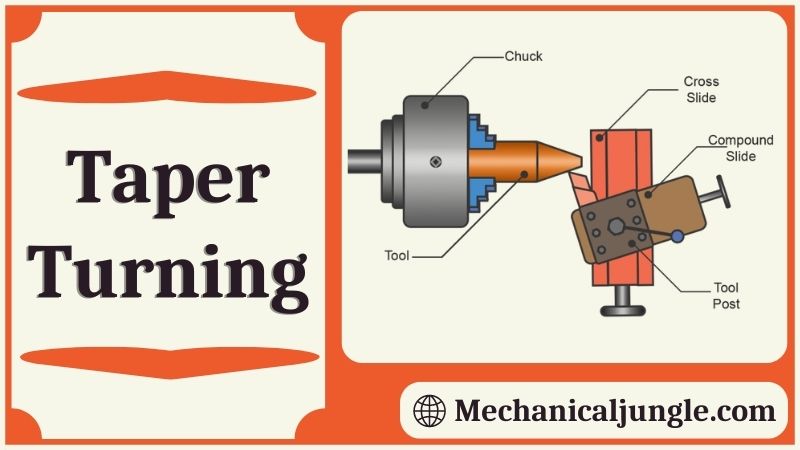
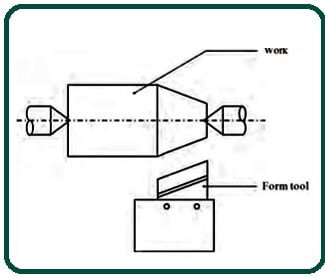
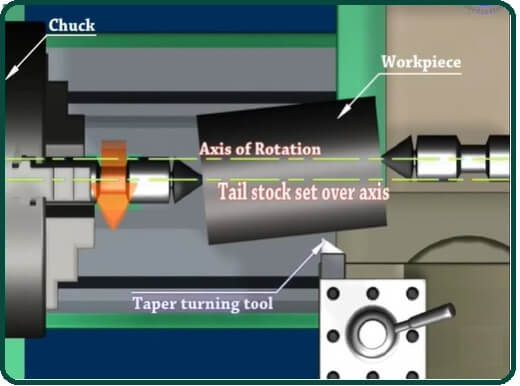
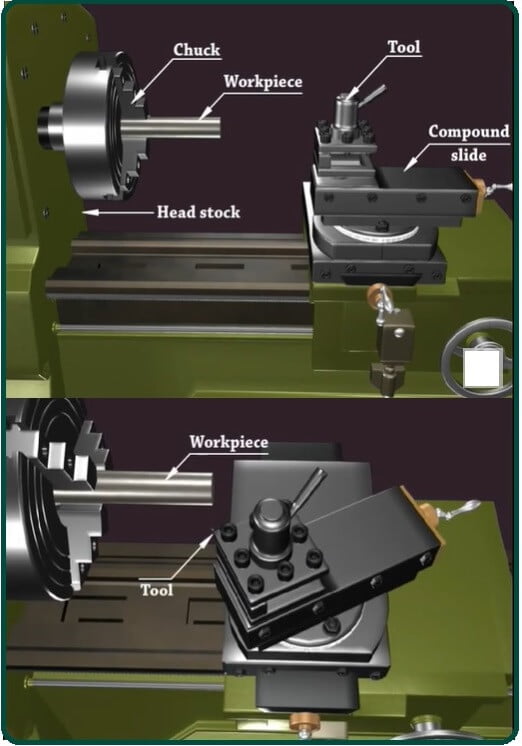
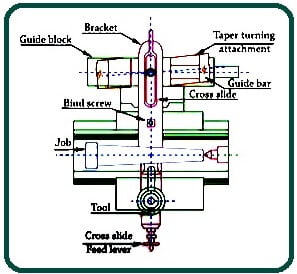

Leave a Reply